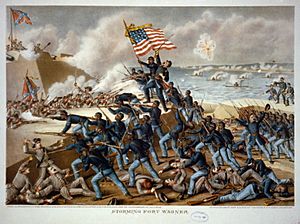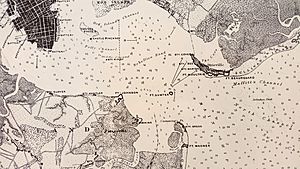Fort Wagner facts for kids
Fort Wagner was a strong fort built on Morris Island in South Carolina. It guarded the southern entrance to Charleston Harbor. This fort was the site of two important battles during the American Civil War in 1863. These battles were part of a larger plan called Operations Against the Defenses of Charleston. United States forces faced many challenges and suffered heavy losses trying to capture the fort.
Contents
Building Fort Wagner: What Was It Like?
Fort Wagner was named after Lt. Col. Thomas M. Wagner, who had passed away. The fort was about 250 yards (228 meters) long and 100 yards (91 meters) wide. It stretched from the Atlantic Ocean on one side to a swamp on the other.
The fort's walls were made of sand and earth. They stood about 30 feet (9 meters) tall above the beach. These walls were made even stronger with palmetto logs and sandbags.
Fort Wagner's Defenses and Weapons
Fort Wagner had fourteen cannons. The biggest one was a 10-inch (254 mm) Columbiad cannon. This powerful cannon could fire a huge 128-pound shell. The fort was large enough to protect nearly 1,000 soldiers from its 1,700-man team. It offered great safety from attacks by naval ships.
The front of the fort, facing the land, had extra protection. There was a water-filled trench that was 10 feet (3 meters) wide and 5 feet (1.5 meters) deep. Around this trench, there were hidden land mines and sharp palmetto stakes. Other defenses across Morris Island also supported the fort.
Battles at Fort Wagner: A Look at the History
Fort Wagner was the scene of two major battles during the Civil War. These fights showed the bravery and challenges faced by soldiers on both sides.
First Battle of Fort Wagner: July 11, 1863
The First Battle of Fort Wagner happened on July 11, 1863. This battle was not as well-known as the second one. In this fight, only 12 Confederate soldiers were killed. However, the United States forces suffered many more losses, with 339 soldiers killed or wounded.
Second Battle of Fort Wagner: July 18, 1863
The Second Battle of Fort Wagner took place a week later, on July 18, 1863. This battle is much more famous. It involved a brave attack by the Union army. This attack was led by the 54th Massachusetts Volunteer Infantry. This was one of the first major American military units made up of black soldiers.
Colonel Robert Gould Shaw led the 54th Massachusetts on foot during their charge. He was sadly killed during the attack. Even though the Union forces did not capture the fort in this battle, it had a big impact. The news of the 54th Massachusetts's bravery helped encourage more black Americans to join the Union army. This gave the Union a greater number of soldiers than the South.
Siege and Abandonment of Fort Wagner
After the unsuccessful attack, Union forces surrounded the fort. They began a long siege, which means they tried to capture it by cutting off supplies and constantly attacking it. By August 25, the Union's trenches were very close to the fort. They tried to attack the Advanced Rifle Pits, which were 240 yards (219 meters) in front of the fort. This attempt failed.
A second attempt by the 24th Massachusetts Infantry on August 26 was successful. After almost 60 days of heavy shelling from the U.S. forces, the Confederates decided to leave the fort. They abandoned it on the night of September 6–7, 1863. Before leaving, they took all their working cannons and the soldiers with them.
The Confederates left the fort because they were worried about losing their soldiers. The heavy artillery fire was damaging the fort's walls and bomb-proof shelters. They feared their soldiers would be destroyed or captured if they stayed.
Fort Wagner's Disappearance
Within 20 years after the Civil War, the remains of Fort Wagner were washed away. The ocean's waves and erosion on Morris Island caused the fort to disappear. By May 1885, a group of former soldiers visited the site. They reported that the entire fort and the areas around it had been swallowed by the ocean.
Why Fort Wagner's Fall Mattered
The capture of Fort Wagner, along with nearby Fort Gregg, meant that Morris Island fell to the United States. Even though Charleston itself remained under Confederate control, its port was effectively closed. This was a huge blow to the Confederacy.
By the end of 1863, the Secretary of the Navy, Gideon Welles, announced that "the commerce of Charleston has ceased." The money the Confederacy made from customs (taxes on goods) dropped sharply from 1863 to 1864. The hard work and sacrifices of the United States forces had successfully shut down a vital supply line for the rebellion.
The 54th Massachusetts: Brave Black Soldiers
The 54th Massachusetts was a very important regiment that fought for the Union at Fort Wagner. It was one of the first African-American regiments in the war. Many people in the North supported ending slavery. However, some still treated African Americans as less important than white people.
Some people wrongly believed that black soldiers could not fight as well as white soldiers. The actions of the 54th Massachusetts at Fort Wagner proved this idea wrong. Black soldiers had fought bravely in wars before, even for the United States.
A Medal of Honor Hero
William Carney, an African American sergeant with the 54th, became a hero at Fort Wagner. He is considered the first black person to receive the Medal of Honor. He earned this award for bravely recovering his unit's American flag during the battle. He then returned it safely to the Union lines.
After the battle, the Confederates buried Colonel Shaw, the commanding officer of the 54th, in an unmarked mass grave. They buried him with the African-American soldiers of his regiment. They meant this as an insult. However, Colonel Shaw's family saw it as an honor that he was buried with his brave men.
Where Are the Soldiers Now?
Morris Island is a small island that is often affected by storms and the sea. Much of the original site of Fort Wagner has been washed away by erosion. This includes the place where the Union soldiers were buried.
However, the soldiers' remains were not there when this happened. Soon after the Civil War ended, the Army moved and reburied all the remains. This included Colonel Shaw's remains. They were reburied at the Beaufort National Cemetery in Beaufort, South Carolina. Their gravestones were marked as "unknown."
Many soldiers were missing and presumed dead at Battery Wagner. The 54th Massachusetts had the most, with 146 missing. It seems many bodies were not removed and were lost to the shifting sea.
Preserving History: Fort Wagner Today
Even though the Atlantic Ocean covered Fort Wagner in the late 1800s, efforts are being made to preserve the area. The Civil War Trust (now part of the American Battlefield Trust) and its partners have bought and protected 118 acres (0.48 km2) of historic Morris Island. This land had gun placements and other military buildings during the war.



